Solid Lubrication at High-Temperatures—A Review
Abstract
1. Introduction
2. Potential High-Temperature Solid-Lubricants
2.1. Soft Metals
2.1.1. Silver (Ag)
2.1.2. Bismuth (Bi)
2.1.3. Other Soft Metals (Au, Cu, In)
2.2. Laminar Solids
2.2.1. Molybdenum Disulfide (MoS2)
2.2.2. Graphite
2.2.3. Graphene
2.2.4. Hexagonal Boron Nitride (hBN)
2.2.5. Tungsten Disulfide (WS2)
2.3. Alkaline-Earth Fluorides
2.4. Lubricious Oxides and Magneli Phases
2.5. Challenges, Opportunities, and Concluding Remarks
Author Contributions
Funding
Conflicts of Interest
References
- Shah, R.; Chen, R.; Woydt, M.; Baumann, C.; Jurs, J.; Iaccarino, P. High Temperature Tribology under Linear Oscillation Motion. Lubricants 2020, 9, 5. [Google Scholar] [CrossRef]
- Yu, H.; Zheng, Z.; Chen, H.; Qiao, D.; Feng, D.; Gong, Z.; Dong, G. An investigation of tribochemical reaction kinetics from the perspective of tribo-oxidation. Tribol. Int. 2021, 165, 107289. [Google Scholar] [CrossRef]
- Kumar, R.; Antonov, M. Self-lubricating materials for extreme temperature tribo-applications. Mater. Today Proc. 2020, 44, 4583–4589. [Google Scholar] [CrossRef]
- Kumar, R.; Antonov, M.; Liu, L.; Hussainova, I. Sliding wear performance of in-situ spark plasma sintered Ti-TiBw composite at temperatures up to 900 °C. Wear 2021, 476, 203663. [Google Scholar] [CrossRef]
- Zhu, S.; Cheng, J.; Qiao, Z.; Yang, J. High temperature solid-lubricating materials: A review. Tribol. Int. 2018, 133, 206–223. [Google Scholar] [CrossRef]
- Marques, A.; Suarez, M.P.; Sales, W.F.; Machado, R. Turning of Inconel 718 with whisker-reinforced ceramic tools applying vegetable-based cutting fluid mixed with solid lubricants by MQL. J. Mater. Process. Technol. 2018, 266, 530–543. [Google Scholar] [CrossRef]
- Antonov, M.; Klimczyk, P.; Kumar, R.; Tamre, M.; Zahavi, A. Performance of Al2O3-cBN materials and the perspective of using hyperspectral imaging during cutting tests. Proc. Est. Acad. Sci. 2021, 70, 524. [Google Scholar] [CrossRef]
- Shi, X.; Zhai, W.; Xu, Z.; Wang, M.; Yao, J.; Song, S.; Wang, Y. Synergetic lubricating effect of MoS2 and Ti3SiC2 on tribological properties of NiAl matrix self-lubricating composites over a wide temperature range. Mater. Des. 2014, 55, 93–103. [Google Scholar] [CrossRef]
- Pelcastre, L.; Hardell, J.; Rolland, A.; Prakash, B. Influence of microstructural evolution of Al-Si coated UHSS on its tribological behaviour against tool steel at elevated temperatures. J. Mater. Process. Technol. 2016, 228, 117–124. [Google Scholar] [CrossRef]
- Torres, H.; Ripoll, M.R.; Prakash, B. Tribological behaviour of self-lubricating materials at high temperatures. Int. Mater. Rev. 2017, 63, 309–340. [Google Scholar] [CrossRef]
- Li, J.; Xiong, D.; Huang, Z.; Kong, J.; Dai, J. Effect of Ag and CeO2 on friction and wear properties of Ni-base composite at high temperature. Wear 2009, 267, 576–584. [Google Scholar] [CrossRef]
- Ye, F.; Lou, Z.; Wang, Y.; Liu, W. Wear mechanism of Ag as solid lubricant for wide range temperature application in micro-beam plasma cladded Ni60 coatings. Tribol. Int. 2021, 167, 107402. [Google Scholar] [CrossRef]
- Aouadi, S.M.; Paudel, Y.; Simonson, W.J.; Ge, Q.; Kohli, P.; Muratore, C.; Voevodin, A.A. Tribological investigation of adaptive Mo2N/MoS2/Ag coatings with high sulfur content. Surf. Coat. Technol. 2009, 203, 1304–1309. [Google Scholar] [CrossRef]
- Torres, H.; Slawik, S.; Gachot, C.; Prakash, B.; Ripoll, M.R. Microstructural design of self-lubricating laser claddings for use in high temperature sliding applications. Surf. Coat. Technol. 2018, 337, 24–34. [Google Scholar] [CrossRef]
- Voevodin, A.; Muratore, C.; Aouadi, S. Hard coatings with high temperature adaptive lubrication and contact thermal management: Review. Surf. Coat. Technol. 2014, 257, 247–265. [Google Scholar] [CrossRef]
- Kumar, R.; Antonov, M.; Holovenko, Y.; Surzhenkov, A. Erosive Wear Resistance of Nature-inspired Flexible Materials. Tribol. Lett. 2020, 68, 1–8. [Google Scholar] [CrossRef]
- Akhtar, S.S. A critical review on self-lubricating ceramic-composite cutting tools. Ceram. Int. 2021, 47, 20745–20767. [Google Scholar] [CrossRef]
- Duan, W.; Sun, Y.; Liu, C.; Liu, S.; Li, Y.; Ding, C.; Ran, G.; Yu, L. Study on the formation mechanism of the glaze film formed on Ni/Ag composites. Tribol. Int. 2016, 95, 324–332. [Google Scholar] [CrossRef]
- Chen, J.; An, Y.; Yang, J.; Zhao, X.; Yan, F.; Zhou, H.; Chen, J. Tribological properties of adaptive NiCrAlY–Ag–Mo coatings prepared by atmospheric plasma spraying. Surf. Coat. Technol. 2013, 235, 521–528. [Google Scholar] [CrossRef]
- Shi, X.; Xu, Z.; Wang, M.; Zhai, W.; Yao, J.; Song, S.; Din, A.Q.U.; Zhang, Q. Tribological behavior of TiAl matrix self-lubricating composites containing silver from 25 to 800 °C. Wear 2013, 303, 486–494. [Google Scholar] [CrossRef]
- Aouadi, S.M.; Paudel, Y.; Luster, B.; Stadler, S.; Kohli, P.; Muratore, C.; Hager, C.; Voevodin, A.A. Adaptive Mo2N/MoS2/Ag tribological nanocomposite coatings for aerospace applications. Tribol. Lett. 2008, 29, 95–103. [Google Scholar] [CrossRef]
- Li, X.; Chen, X.; Zhang, C.; Luo, J. Preparation of self-lubricating NiTi alloy and its self-adaptive behavior. Tribol. Int. 2018, 130, 43–51. [Google Scholar] [CrossRef]
- Cheng, J.; Zhu, S.; Tan, H.; Yu, Y.; Yang, J.; Liu, W. Lead-bismuth liquid metal: Lubrication behaviors. Wear 2019, 430–431, 94–99. [Google Scholar] [CrossRef]
- Rosales, I.; Gonzalez-Rodriguez, G.; Gama, J.L.; Guardian, R. Bismuth Effect on the Mechanical Properties of Antifriction Al-Sn Alloys. Mater. Sci. Appl. 2014, 5, 330–337. [Google Scholar] [CrossRef]
- Oksanen, V.; Lehtovaara, A.; Kallio, M. Load capacity of lubricated bismuth bronze bimetal bearing under elliptical sliding motion. Wear 2017, 388–389, 72–80. [Google Scholar] [CrossRef]
- Thomson, J.; Zavadil, R.; Sahoo, M.; Dadouche, A.; Dmochowski, W.; Conlon, M. Development of a Lead-Free Bearing Material for Aerospace Applications. Int. J. Met. 2010, 4, 19–30. [Google Scholar] [CrossRef]
- Chen, K.; Wu, X.; Zhang, A.; Zhang, J.; Chen, X.; Zhu, Y.; Wang, Z. Development of wear resistant Cu-12Sn-1.5Ni alloy via minor addition of Fe during casting process. Appl. Surf. Sci. 2022, 573, 151623. [Google Scholar] [CrossRef]
- Liu, C.; Yin, Y.; Li, C.; Xu, M.; Li, R.; Chen, Q. Tailoring Cu nano Bi self-lubricating alloy material by shift-speed ball milling flake powder metallurgy. J. Alloy. Compd. 2022, 903, 163747. [Google Scholar] [CrossRef]
- Liu, C.; Yin, Y.; Li, C.; Xu, M.; Li, R.; Chen, Q. Properties of lead-free copper matrix composites prepared through in situ Ni-coated FeS surface modification and mechanical alloying. J. Alloy. Compd. 2021, 881, 160580. [Google Scholar] [CrossRef]
- Kallio, M.; Vuorinen, P.; Fuentes, E.; Maraña, O.; Ruusila, V.; Nyyssönen, T.; Kuokkala, V.T.; Lehtovaara, A. Tribological Behavior of Bronze Alloys with Solid Lubricants. Key Eng. Mater. 2012, 527, 205–210. [Google Scholar] [CrossRef]
- Heymans, G.; Muñoz, A.I.; Mischler, S. Tribological behaviour of galvanic gold coatings reinforced with silica nanoparticles. Wear 2020, 462–463, 203512. [Google Scholar] [CrossRef]
- Voevodin, A.; Hu, J.; Fitz, T.; Zabinski, J. Tribological properties of adaptive nanocomposite coatings made of yttria stabilized zirconia and gold. Surf. Coat. Technol. 2001, 146-147, 351–356. [Google Scholar] [CrossRef]
- Ouyang, J.H.; Sasaki, S.; Murakami, T.; Umeda, K. The synergistic effects of CaF2 and Au lubricants on tribological properties of spark-plasma-sintered ZrO2 (Y2O3) matrix composites. Mater. Sci. Eng. A 2004, 386, 234–243. [Google Scholar] [CrossRef]
- Magnin, V.; Mischler, S. Tribological response of multilayered gold nickel coating deposited on fine turned surfaces. Wear 2019, 426–427, 1195–1202. [Google Scholar] [CrossRef]
- Chen, Z.; Wagner, J.; Turq, V.; Hillairet, J.; Taberna, P.-L.; Laloo, R.; Duluard, S.; Bernard, J.-M.; Song, Y.; Yang, Q.; et al. Surfactant-assisted electrodeposition of Au–Co/WS2 self-lubricating coating from WS2 suspended cyanide electrolyte. J. Alloy. Compd. 2020, 829, 154585. [Google Scholar] [CrossRef]
- Wang, Y.; Worzala, F.; Lefkow, A. Friction and wear properties of partially stabilized zirconia with solid lubricant. Wear 1993, 167, 23–31. [Google Scholar] [CrossRef]
- Österle, W.; Prietzel, C.; Kloß, H.; Dmitriev, A. On the role of copper in brake friction materials. Tribol. Int. 2010, 43, 2317–2326. [Google Scholar] [CrossRef]
- Kato, H.; Takama, M.; Iwai, Y.; Washida, K.; Sasaki, Y. Wear and mechanical properties of sintered copper–tin composites containing graphite or molybdenum disulfide. Wear 2003, 255, 573–578. [Google Scholar] [CrossRef]
- Guleryuz, C.G.; Krzanowski, J.E.; Veldhuis, S.C.; Fox-Rabinovich, G.S. Machining performance of TiN coatings incorporating indium as a solid lubricant. Surf. Coat. Technol. 2009, 203, 3370–3376. [Google Scholar] [CrossRef]
- Zhang, X.; Sun, W.; Ma, H.; Xu, H.; Dong, J. Investigation of the Tribological Properties of Two Different Layered Sodium Silicates Utilized as Solid Lubrication Additives in Lithium Grease. Ind. Eng. Chem. Res. 2013, 53, 182–188. [Google Scholar] [CrossRef]
- Vazirisereshk, M.R.; Martini, A.; Strubbe, D.A.; Baykara, M.Z. Solid Lubrication with MoS2: A Review. Lubricants 2019, 7, 57. [Google Scholar] [CrossRef]
- Furlan, K.P.; de Mello, J.D.B.; Klein, A.N. Self-lubricating composites containing MoS2: A review. Tribol. Int. 2018, 120, 280–298. [Google Scholar] [CrossRef]
- Ripoll, M.R.; Tomala, A.M.; Pirker, L.; Remškar, M. In-Situ Formation of MoS2 and WS2 Tribofilms by the Synergy between Transition Metal Oxide Nanoparticles and Sulphur-Containing Oil Additives. Tribol. Lett. 2020, 68, 41. [Google Scholar] [CrossRef]
- Gopinath, V.M.; Arulvel, S. A review on the steels, alloys/high entropy alloys, composites and coatings used in high temperature wear applications. Mater. Today Proc. 2020, 43, 817–823. [Google Scholar] [CrossRef]
- Jing, W.; Du, S.; Chen, S.; Liu, E.; Du, H.; Cai, H. Tribological behavior of VN-MoS2/Ag composites over a wide temperature range. Tribol. Trans. 2022, 65, 66–77. [Google Scholar] [CrossRef]
- Afanasiev, P.; Lorentz, C. Oxidation of Nanodispersed MoS2 in Ambient Air: The Products and the Mechanistic Steps. J. Phys. Chem. C 2019, 123, 7486–7494. [Google Scholar] [CrossRef]
- Shi, X.; Zhai, W.; Wang, M.; Xu, Z.; Yao, J.; Song, S.; Wang, Y. Tribological behaviors of NiAl based self-lubricating composites containing different solid lubricants at elevated temperatures. Wear 2014, 310, 1–11. [Google Scholar] [CrossRef]
- Kong, L.; Bi, Q.; Niu, M.; Zhu, S.; Yang, J.; Liu, W. ZrO2 (Y2O3)–MoS2–CaF2 self-lubricating composite coupled with different ceramics from 20 °C to 1000 °C. Tribol. Int. 2013, 64, 53–62. [Google Scholar] [CrossRef]
- Hardell, J.; Efeoglu, I.; Prakash, B. Tribological degradation of MoS2–Ti sputtered coating when exposed to elevated temperatures. Tribol.-Mater. Surf. Interfaces 2010, 4, 121–129. [Google Scholar] [CrossRef]
- Muratore, C.; Voevodin, A.; Hu, J.; Zabinski, J. Tribology of adaptive nanocomposite yttria-stabilized zirconia coatings containing silver and molybdenum from 25 to 700 °C. Wear 2006, 261, 797–805. [Google Scholar] [CrossRef]
- Niu, M.; Bi, Q.; Zhu, S.; Yang, J.; Liu, W. Microstructure, phase transition and tribological performances of Ni3Si-based self-lubricating composite coatings. J. Alloy. Compd. 2013, 555, 367–374. [Google Scholar] [CrossRef]
- Serpini, E.; Rota, A.; Ballestrazzi, A.; Marchetto, D.; Gualtieri, E.; Valeri, S. The role of humidity and oxygen on MoS2 thin films deposited by RF PVD magnetron sputtering. Surf. Coat. Technol. 2017, 319, 345–352. [Google Scholar] [CrossRef]
- Hu, J.; Bultman, J.; Muratore, C.; Phillips, B.; Zabinski, J.; Voevodin, A. Tribological properties of pulsed laser deposited Mo–S–Te composite films at moderate high temperatures. Surf. Coat. Technol. 2009, 203, 2322–2327. [Google Scholar] [CrossRef]
- Zhou, Y.; Dong, Y.; Yin, H.; Li, Z.; Yan, R.; Li, D.; Gu, Z.; Sun, X.; Shi, L.; Zhang, Z. Characterizing thermal-oxidation behaviors of nuclear graphite by combining O2 supply and micro surface area of graphite. Sci. Rep. 2018, 8, 13400. [Google Scholar] [CrossRef] [PubMed]
- Li, C.; Chen, X.; Shen, L.; Bao, N. Revisiting the Oxidation of Graphite: Reaction Mechanism, Chemical Stability, and Structure Self-Regulation. ACS Omega 2020, 5, 3397–3404. [Google Scholar] [CrossRef]
- Kim, T.; Singh, D.; Singh, M. Enhancement of Oxidation Resistance of Graphite Foams by Polymer Derived-silicon Carbide Coating for Concentrated Solar Power Applications. Energy Procedia 2015, 69, 900–906. [Google Scholar] [CrossRef][Green Version]
- Huai, W.; Zhang, C.; Wen, S. Graphite-based solid lubricant for high-temperature lubrication. Friction 2020, 9, 1660–1672. [Google Scholar] [CrossRef]
- Tan, H.; Wang, S.; Yu, Y.; Cheng, J.; Zhu, S.; Qiao, Z.; Yang, J. Friction and wear properties of Al-20Si-5Fe-2Ni-Graphite solid-lubricating composite at elevated temperatures. Tribol. Int. 2018, 122, 228–235. [Google Scholar] [CrossRef]
- Mushtaq, S.; Wani, M.F. High-temperature friction and wear studies of Fe-Cu-Sn alloy with graphite as solid lubricant under dry sliding conditions. Mater. Res. Express 2018, 5, 026504. [Google Scholar] [CrossRef]
- Zhen, J.; Zhu, S.; Cheng, J.; Li, M.; Lu, Y.; Qiao, Z.; Yang, J. Influence of graphite content on the dry sliding behavior of nickel alloy matrix solid lubricant composites. Tribol. Int. 2017, 114, 322–328. [Google Scholar] [CrossRef]
- Lu, J.; Yang, S.; Wang, J.; Xue, Q. Mechanical and tribological properties of Ni-based alloy/CeF3/graphite high temperature self-lubricating composites. Wear 2001, 249, 1070–1076. [Google Scholar] [CrossRef]
- Cho, M.H.; Ju, J.; Kim, S.J.; Jang, H. Tribological properties of solid lubricants (graphite, Sb2S3, MoS2) for automotive brake friction materials. Wear 2006, 260, 855–860. [Google Scholar] [CrossRef]
- Kong, L.; Zhu, S.; Bi, Q.; Qiao, Z.; Yang, J.; Liu, W. Friction and wear behavior of self-lubricating ZrO2 (Y2O3)–CaF2–Mo–graphite composite from 20 °C to 1000 °C. Ceram. Int. 2014, 40, 10787–10792. [Google Scholar] [CrossRef]
- Li, J.L.; Xiong, D.S. Tribological properties of nickel-based self-lubricating composite at elevated temperature and counterface material selection. Wear 2008, 265, 533–539. [Google Scholar] [CrossRef]
- Bijwe, J.; Kumar, K.; Panda, J.N.; Parida, T.; Trivedi, P. Design and development of high performance tribo-composites based on synergism in two solid lubricants. Compos. Part B Eng. 2016, 94, 399–410. [Google Scholar] [CrossRef]
- Sun, Q.; Wang, Z.; Yin, B.; Yang, J.; Liu, J.; Liu, Y.; Cheng, J.; Zhu, S.; Qiao, Z. The tribological properties and wear mechanism of copper coated graphite doped Sialon ceramic composites at wide range temperature from 25 to 800 °C. Tribol. Int. 2018, 123, 10–16. [Google Scholar] [CrossRef]
- Wang, Y.; Gao, Y.; Li, Y.; Li, M.; Sun, L.; Zhai, W.; Li, K. Research on synergistic lubrication effect of silver modified Cu–Ni-graphite composite. Wear 2019, 444–445, 203140. [Google Scholar] [CrossRef]
- Berman, D.; Erdemir, A.; Sumant, A.V. Graphene: A new emerging lubricant. Mater. Today 2014, 17, 31–42. [Google Scholar] [CrossRef]
- Kumar, P.; Wani, M.F. Synthesis and tribological properties of graphene: A review. J. Tribol. 2017, 13, 36–71. [Google Scholar]
- Essa, F.A.; Elsheikh, A.H.; Yu, J.; Elkady, O.A.; Saleh, B. Studies on the effect of applied load, sliding speed and temperature on the wear behavior of M50 steel reinforced with Al2O3 and/or graphene nanoparticles. J. Mater. Res. Technol. 2021, 12, 283–303. [Google Scholar] [CrossRef]
- Xiao, Y.; Shi, X.; Zhai, W.; Yang, K.; Yao, J. Effect of Temperature on Tribological Properties and Wear Mechanisms of NiAl Matrix Self-Lubricating Composites Containing Graphene Nanoplatelets. Tribol. Trans. 2015, 58, 729–735. [Google Scholar] [CrossRef]
- Xu, Z.; Zhang, Q.; Jing, P.; Zhai, W. High-Temperature Tribological Performance of TiAl Matrix Composites Reinforced by Multilayer Graphene. Tribol. Lett. 2015, 58, 1–9. [Google Scholar] [CrossRef]
- Wei, M.; Wang, S.; Cui, X. Comparative research on wear characteristics of spheroidal graphite cast iron and carbon steel. Wear 2012, 274–275, 84–93. [Google Scholar] [CrossRef]
- Podgornik, B.; Kosec, T.; Kocijan, A.; Donik, Č. Tribological behaviour and lubrication performance of hexagonal boron nitride (h-BN) as a replacement for graphite in aluminium forming. Tribol. Int. 2015, 81, 267–275. [Google Scholar] [CrossRef]
- Zhang, S.; Zhou, J.; Guo, B.; Zhou, H.; Pu, Y.; Chen, J. Friction and wear behavior of laser cladding Ni/hBN self-lubricating composite coating. Mater. Sci. Eng. A 2008, 491, 47–54. [Google Scholar] [CrossRef]
- Lu, X.-L.; Liu, X.-B.; Yu, P.-C.; Qiao, S.-J.; Zhai, Y.-J.; Wang, M.-D.; Chen, Y.; Xu, D. Synthesis and characterization of Ni60-hBN high temperature self-lubricating anti-wear composite coatings on Ti6Al4V alloy by laser cladding. Opt. Laser Technol. 2015, 78, 87–94. [Google Scholar] [CrossRef]
- Kumar, R.; Aydinyan, S.; Ivanov, R.; Liu, L.; Antonov, M.; Hussainova, I. High-Temperature Wear Performance of hBN-Added Ni-W Composites Produced from Combustion-Synthesized Powders. Materials 2022, 15, 1252. [Google Scholar] [CrossRef]
- Torres, H.; Podgornik, B.; Jovičević-Klug, M.; Ripoll, M.R. Compatibility of graphite, hBN and graphene with self-lubricating coatings and tool steel for high temperature aluminium forming. Wear 2021, 490–491, 204187. [Google Scholar] [CrossRef]
- Du, L.; Huang, C.; Zhang, W.; Li, T.; Liu, W. Preparation and wear performance of NiCr/Cr3C2–NiCr/hBN plasma sprayed composite coating. Surf. Coat. Technol. 2011, 205, 3722–3728. [Google Scholar] [CrossRef]
- Zhu, X.; Wei, X.; Huang, Y.; Wang, F.; Yan, P. High-Temperature Friction and Wear Properties of NiCr/hBN Self-Lubricating Composites. Metals 2019, 9, 356. [Google Scholar] [CrossRef]
- Tyagi, R.; Xiong, D.; Li, J.; Dai, J. Elevated temperature tribological behavior of Ni based composites containing nano-silver and hBN. Wear 2010, 269, 884–890. [Google Scholar] [CrossRef]
- Zhang, Y.; Wang, W.; Hu, Z.; Liu, K.; Chang, J. Investigation of hBN powder lubricating characteristics of die steel H13–ceramic Si3N4 tribopair at 800 °C. Proc. Inst. Mech. Eng. Part J. Eng. Tribol. 2019, 234, 622–631. [Google Scholar] [CrossRef]
- Chen, J.; Chen, J.; Wang, S.; Sun, Q.; Cheng, J.; Yu, Y.; Yang, J. Tribological properties of h-BN matrix solid-lubricating composites under elevated temperatures. Tribol. Int. 2020, 148, 106333. [Google Scholar] [CrossRef]
- Yan, H.; Zhang, P.; Gao, Q.; Qin, Y.; Li, R. Laser cladding Ni-based alloy/nano-Ni encapsulated h-BN self-lubricating composite coatings. Surf. Coat. Technol. 2017, 332, 422–427. [Google Scholar] [CrossRef]
- Zhang, W.; Yi, M.; Xiao, G.; Ma, J.; Wu, G.; Xu, C. Al2O3-coated h-BN composite powders and as-prepared Si3N4-based self-lubricating ceramic cutting tool material. Int. J. Refract. Met. Hard Mater. 2018, 71, 1–7. [Google Scholar] [CrossRef]
- Chen, H.; Xu, C.; Xiao, G.; Chen, Z.; Ma, J.; Wu, G. Synthesis of (h-BN)/SiO2 core–shell powder for improved self-lubricating ceramic composites. Ceram. Int. 2016, 42, 5504–5511. [Google Scholar] [CrossRef]
- Essa, F.; Zhang, Q.; Huang, X. Investigation of the effects of mixtures of WS2 and ZnO solid lubricants on the sliding friction and wear of M50 steel against silicon nitride at elevated temperatures. Wear 2017, 374–375, 128–141. [Google Scholar] [CrossRef]
- Heshmat, H.; Hryniewicz, P.; Ii, J.F.W.; Willis, J.P.; Jahanmir, S.; DellaCorte, C. Low-friction wear-resistant coatings for high-temperature foil bearings. Tribol. Int. 2005, 38, 1059–1075. [Google Scholar] [CrossRef]
- Wang, Q.; Chen, M.; Shan, Z.; Sui, C.; Zhang, L.; Zhu, S.; Wang, F. Comparative study of mechanical and wear behavior of Cu/WS2 composites fabricated by spark plasma sintering and hot pressing. J. Mater. Sci. Technol. 2017, 33, 1416–1423. [Google Scholar] [CrossRef]
- Shi, X.; Song, S.; Zhai, W.; Wang, M.; Xu, Z.; Yao, J.; Din, A.Q.U.; Zhang, Q. Tribological behavior of Ni3Al matrix self-lubricating composites containing WS2, Ag and hBN tested from room temperature to 800 °C. Mater. Des. 2014, 55, 75–84. [Google Scholar] [CrossRef]
- Xu, Z.; Zhang, Q.; Zhai, W. Tribological properties of TiAl matrix self-lubricating composites incorporated with tungsten disulfide and zinc oxide. RSC Adv. 2015, 5, 45044–45052. [Google Scholar] [CrossRef]
- Yang, M.-S.; Liu, X.-B.; Fan, J.-W.; He, X.-M.; Shi, S.-H.; Fu, G.-Y.; Wang, M.-D.; Chen, S.-F. Microstructure and wear behaviors of laser clad NiCr/Cr3C2–WS2 high temperature self-lubricating wear-resistant composite coating. Appl. Surf. Sci. 2012, 258, 3757–3762. [Google Scholar] [CrossRef]
- Kim, S.-H.; Lee, S.W. Wear and friction behavior of self-lubricating alumina–zirconia–fluoride composites fabricated by the PECS technique. Ceram. Int. 2014, 40, 779–790. [Google Scholar] [CrossRef]
- Kumar, R.; Antonov, M.; Beste, U.; Goljandin, D. Assessment of 3D printed steels and composites intended for wear applications in abrasive, dry or slurry erosive conditions. Int. J. Refract. Met. Hard Mater. 2019, 86, 105126. [Google Scholar] [CrossRef]
- Kong, L.; Bi, Q.; Zhu, S.; Yang, J.; Liu, W. Tribological properties of ZrO2 (Y2O3)–Mo–BaF2/CaF2 composites at high temperatures. Tribol. Int. 2012, 45, 43–49. [Google Scholar] [CrossRef]
- Mazumder, S.; Metselaar, H.S.C.; Sukiman, N.L.; Zulkifli, N.W.M. An overview of fluoride-based solid lubricants in sliding contacts. J. Eur. Ceram. Soc. 2020, 40, 4974–4996. [Google Scholar] [CrossRef]
- Ouyang, J.; Li, Y.; Wang, Y.; Zhou, Y.; Murakami, T.; Sasaki, S. Microstructure and tribological properties of ZrO2(Y2O3) matrix composites doped with different solid lubricants from room temperature to 800 °C. Wear 2009, 267, 1353–1360. [Google Scholar] [CrossRef]
- Jin, Y.; Kato, K.; Umehara, N. Tribological properties of self-lubricating CMC/Al2O3 pairs at high temperature in air. Tribol. Lett. 1998, 4, 243–250. [Google Scholar] [CrossRef]
- Cura, M.E.; Kim, S.-H.; Muukkonen, T.; Varjus, S.; Vaajoki, A.; Söderberg, O.; Suhonen, T.; Kanerva, U.; Lee, S.W.; Hannula, S.-P. Microstructure and tribological properties of pulsed electric current sintered alumina–zirconia nanocomposites with different solid lubricants. Ceram. Int. 2012, 39, 2093–2105. [Google Scholar] [CrossRef]
- Murakami, T.; Ouyang, J.H.; Sasaki, S.; Umeda, K.; Yoneyama, Y. High-temperature tribological properties of Al2O3, Ni–20 mass% Cr and NiAl spark-plasma-sintered composites containing BaF2–CaF2 phase. Wear 2005, 259, 626–633. [Google Scholar] [CrossRef]
- Li, F.; Zhu, S.; Cheng, J.; Qiao, Z.; Yang, J. Tribological properties of Mo and CaF2 added SiC matrix composites at elevated temperatures. Tribol. Int. 2017, 111, 46–51. [Google Scholar] [CrossRef]
- Cheng, J.; Qiao, Z.; Yin, B.; Hao, J.; Yang, J.; Liu, W. High temperature tribological behaviors of (WAl)C–Co ceramic composites with the additions of fluoride solid lubricants. Mater. Chem. Phys. 2015, 163, 262–271. [Google Scholar] [CrossRef]
- Kumar, R.; Liu, L.; Antonov, M.; Ivanov, R.; Hussainova, I. Hot Sliding Wear of 88 wt.% TiB–Ti Composite from SHS Produced Powders. Materials 2021, 14, 1242. [Google Scholar] [CrossRef] [PubMed]
- Kumar, R.; Malaval, B.; Antonov, M.; Zhao, G. Performance of polyimide and PTFE based composites under sliding, erosive and high stress abrasive conditions. Tribol. Int. 2020, 147, 106282. [Google Scholar] [CrossRef]
- Valefi, M.; de Rooij, M.; Schipper, D.J.; Winnubst, L. Effect of temperature on friction and wear behaviour of CuO–zirconia composites. J. Eur. Ceram. Soc. 2012, 32, 2235–2242. [Google Scholar] [CrossRef]
- Zhu, S.; Bi, Q.; Niu, M.; Yang, J.; Liu, W. Tribological behavior of NiAl matrix composites with addition of oxides at high temperatures. Wear 2012, 274–275, 423–434. [Google Scholar] [CrossRef]
- Zhu, S.; Cheng, J.; Qiao, Z.; Tian, Y.; Yang, J. High Temperature Lubricating Behavior of NiAl Matrix Composites with Addition of CuO. J. Tribol. 2016, 138, 031607. [Google Scholar] [CrossRef]
- Berger, L.M.; Stahr, C.C.; Saaro, S.; Thiele, S.; Woydt, M.; Kelling, N. Dry sliding up to 7.5 m/s and 800 C of thermally sprayed coatings of the TiO2–Cr2O3 system and (Ti,Mo)(C,N)–Ni(Co). Wear 2009, 267, 954–964. [Google Scholar] [CrossRef]
- Cura, M.E. Ceramic Composites with Solid Lubricants Processed by Pulsed Electric Current Sintering. Ph.D. Thesis, Aalto University, Helsinki, Finland, 2021. [Google Scholar]
- Gassner, G.; Mayrhofer, P.H.; Kutschej, K.; Mitterer, C.; Kathrein, M. Magnéli phase formation of PVD Mo–N and W–N coatings. Surf. Coat. Technol. 2006, 201, 3335–3341. [Google Scholar] [CrossRef]
- Cura, M.; Liu, X.; Kanerva, U.; Varjus, S.; Kivioja, A.; Söderberg, O.; Hannula, S.-P. Friction behavior of alumina/molybdenum composites and formation of MoO3−x phase at 400 °C. Tribol. Int. 2015, 87, 23–31. [Google Scholar] [CrossRef]
- Cura, M.E.; Trebala, M.; Ge, Y.; Klimczyk, P.; Hannula, S.-P. Mechanical and tribological properties of WO2.9 and ZrO2 + WO2.9 composites studied by nanoindentation and reciprocating wear tests. Wear 2021, 478-479, 203920. [Google Scholar] [CrossRef]
- Polcar, T.; Parreira, N.; Cavaleiro, A. Tungsten oxide with different oxygen contents: Sliding properties. Vacuum 2007, 81, 1426–1429. [Google Scholar] [CrossRef]
- Liu, L.; Ivanov, R.; Kumar, R.; Minasyan, T.; Antonov, M.; Hussainova, I. Functionally Gradient Ti6Al4V-TiB Composite Produced by Spark Plasma Sintering. In Materials Science and Engineering; IOP Conference Series; IOP Publishing: Bristol, UK, 2021; Volume 1140, p. 012004. [Google Scholar]
- Lu, Y.; Matsuda, Y.; Sagara, K.; Hao, L.; Otomitsu, T.; Yoshida, H. Fabrication and Thermoelectric Properties of Magneli Phases by Adding Ti into TiO2. Adv. Mater. Res. 2011, 415–417, 1291–1296. [Google Scholar] [CrossRef]
- Gardos, M.N. Magnéli phases of anion-deficient rutile as lubricious oxides. Part I. Tribological behavior of single-crystal and polycrystalline rutile (TinO2n−1). Tribol. Lett. 2000, 8, 65–78. [Google Scholar] [CrossRef]
- Franz, R.; Mitterer, C. Vanadium containing self-adaptive low-friction hard coatings for high-temperature applications: A review. Surf. Coat. Technol. 2013, 228, 1–13. [Google Scholar] [CrossRef]
- Ouyang, J.; Murakami, T.; Sasaki, S. High-temperature tribological properties of a cathodic arc ion-plated (V,Ti)N coating. Wear 2007, 263, 1347–1353. [Google Scholar] [CrossRef]
- Franz, R.; Neidhardt, J.; Kaindl, R.; Sartory, B.; Tessadri, R.; Lechthaler, M.; Polcik, P.; Mitterer, C. Influence of phase transition on the tribological performance of arc-evaporated AlCrVN hard coatings. Surf. Coat. Technol. 2009, 203, 1101–1105. [Google Scholar] [CrossRef]
- Fateh, N.; Fontalvo, G.; Gassner, G.; Mitterer, C. Influence of high-temperature oxide formation on the tribological behaviour of TiN and VN coatings. Wear 2007, 262, 1152–1158. [Google Scholar] [CrossRef]
- Wang, Y.; Lee, J.-W.; Duh, J.-G. Mechanical strengthening in self-lubricating CrAlN/VN multilayer coatings for improved high-temperature tribological characteristics. Surf. Coat. Technol. 2016, 303, 12–17. [Google Scholar] [CrossRef]
- Fateh, N.; Fontalvo, G.A.; Gassner, G.; Mitterer, C. The Beneficial Effect of High-Temperature Oxidation on the Tribological Behaviour of V and VN Coatings. Tribol. Lett. 2007, 28, 1–7. [Google Scholar] [CrossRef]
- Kamath, G.; Ehiasarian, A.; Purandare, Y.; Hovsepian, P. Tribological and oxidation behaviour of TiAlCN/VCN nanoscale multilayer coating deposited by the combined HIPIMS/(HIPIMS-UBM) technique. Surf. Coat. Technol. 2011, 205, 2823–2829. [Google Scholar] [CrossRef]
- Wang, J.Y.; Shan, Y.; Guo, H.; Li, B.; Wang, W.; Jia, J. Friction and wear characteristics of Hot-pressed NiCr–Mo/MoO3/Ag self-lubrication composites at elevated temperatures up to 900 °C. Tribol. Lett. 2015, 59, 1–16. [Google Scholar] [CrossRef]
- Liu, E.-Y.; Wang, W.-Z.; Gao, Y.-M.; Jia, J.-H. Tribological Properties of Adaptive Ni-Based Composites with Addition of Lubricious Ag2MoO4 at Elevated Temperatures. Tribol. Lett. 2012, 47, 21–30. [Google Scholar] [CrossRef]
- Liu, E.; Bai, Y.; Gao, Y.; Yi, G.; Jia, J. Tribological properties of NiAl-based composites containing Ag3VO4 nanoparticles at elevated temperatures. Tribol. Int. 2014, 80, 25–33. [Google Scholar] [CrossRef]
- Liu, E.; Gao, Y.; Bai, Y.; Yi, G.; Wang, W.; Zeng, Z.; Jia, J. Tribological properties of self-lubricating NiAl/Mo-based composites containing AgVO3 nanowires. Mater. Charact. 2014, 97, 116–124. [Google Scholar] [CrossRef]
- Rajeswari, K.; Hareesh, U.; Subasri, R.; Chakravarty, D.; Johnson, R. Comparative evaluation of spark plasma (SPS), microwave (MWS),two stage sintering (TSS) and conventional sintering (CRH) on the densification and micro structural evolution of fully stabilized zirconia ceramics. Sci. Sinter. 2010, 42, 259–267. [Google Scholar] [CrossRef]
- Reichardt, A.; Shapiro, A.A.; Otis, R.; Dillon, R.P.; Borgonia, J.P.; McEnerney, B.W.; Hosemann, P.; Beese, A.M. Advances in additive manufacturing of metal-based functionally graded materials. Int. Mater. Rev. 2020, 66, 1–29. [Google Scholar] [CrossRef]
- Gladman, A.S.; Matsumoto, E.A.; Nuzzo, R.G.; Mahadevan, L.; Lewis, J.A. Biomimetic 4D printing. Nat. Mater. 2016, 15, 413–418. [Google Scholar] [CrossRef]
- Yu, G.; Tian, P.; Ren, K.; Wu, W.; Zhang, Z.; Gong, Z.; Zhang, J. Effects of water molecules on the formation of transfer films and the occurrence of superlow friction. Ceram. Int. 2021, 47, 21325–21333. [Google Scholar] [CrossRef]
- Bhowmick, S.; Shirzadian, S.; Alpas, A.T. High-temperature tribological behavior of Ti containing diamond-like carbon coatings with emphasis on running-in coefficient of friction. Surf. Coat. Technol. 2021, 431, 127995. [Google Scholar] [CrossRef]
- Bhaumik, S.; Pathak, S.; Dey, S.; Datta, S. Artificial intelligence based design of multiple friction modifiers dispersed castor oil and evaluating its tribological properties. Tribol. Int. 2019, 140, 105813. [Google Scholar] [CrossRef]
- Rosenkranz, A.; Costa, H.L.; Baykara, M.Z.; Martini, A. Synergetic effects of surface texturing and solid lubricants to tailor friction and wear—A review. Tribol. Int. 2021, 155, 106792. [Google Scholar] [CrossRef]
- Kumar, R.; Antonov, M.; Klimczyk, P.; Mikli, V.; Gomon, D. Effect of cBN content and additives on sliding and surface fatigue wear of spark plasma sintered Al2O3-cBN composites. Wear 2022, 494–495, 204250. [Google Scholar] [CrossRef]
- Rosenkranz, A.; Marian, M.; Profito, F.J.; Aragon, N.; Shah, R. The Use of Artificial Intelligence in Tribology—A Perspective. Lubricants 2021, 9, 2. [Google Scholar] [CrossRef]
- Gong, H.; Yu, C.; Zhang, L.; Xie, G.; Guo, D.; Luo, J. Intelligent lubricating materials: A review. Compos. Part B Eng. 2020, 202, 108450. [Google Scholar] [CrossRef]
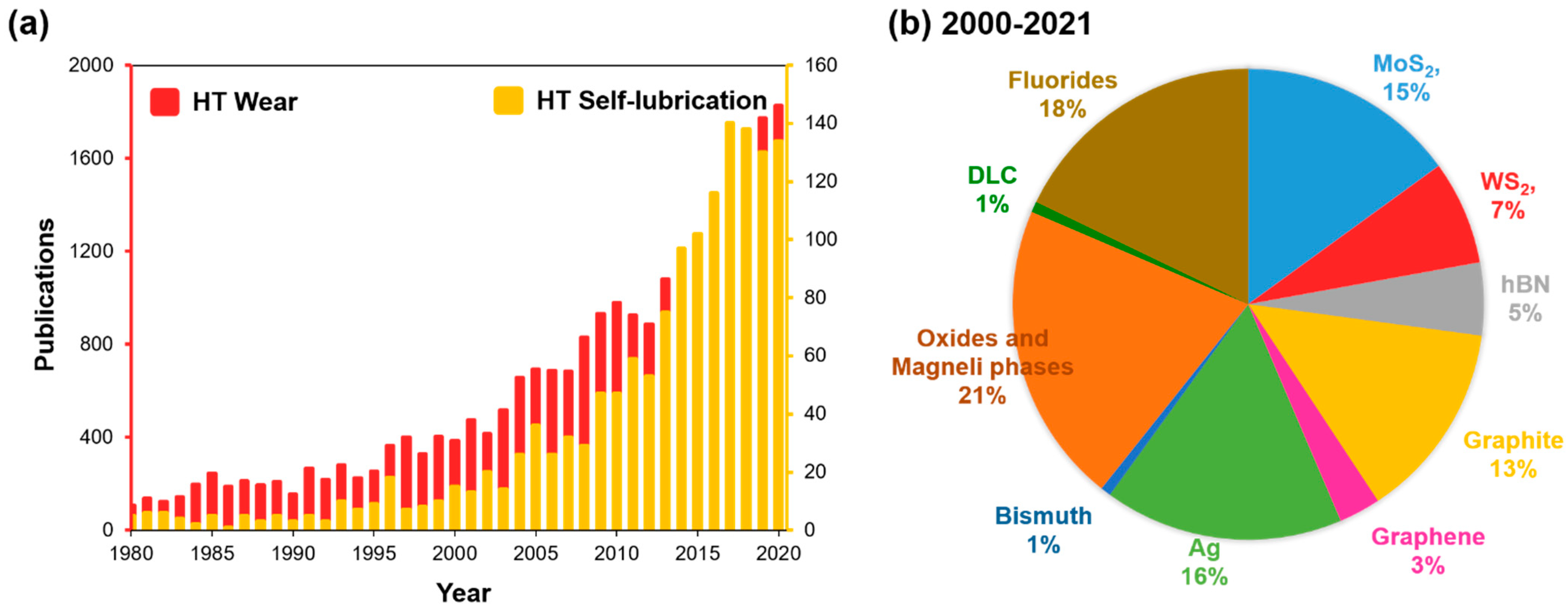
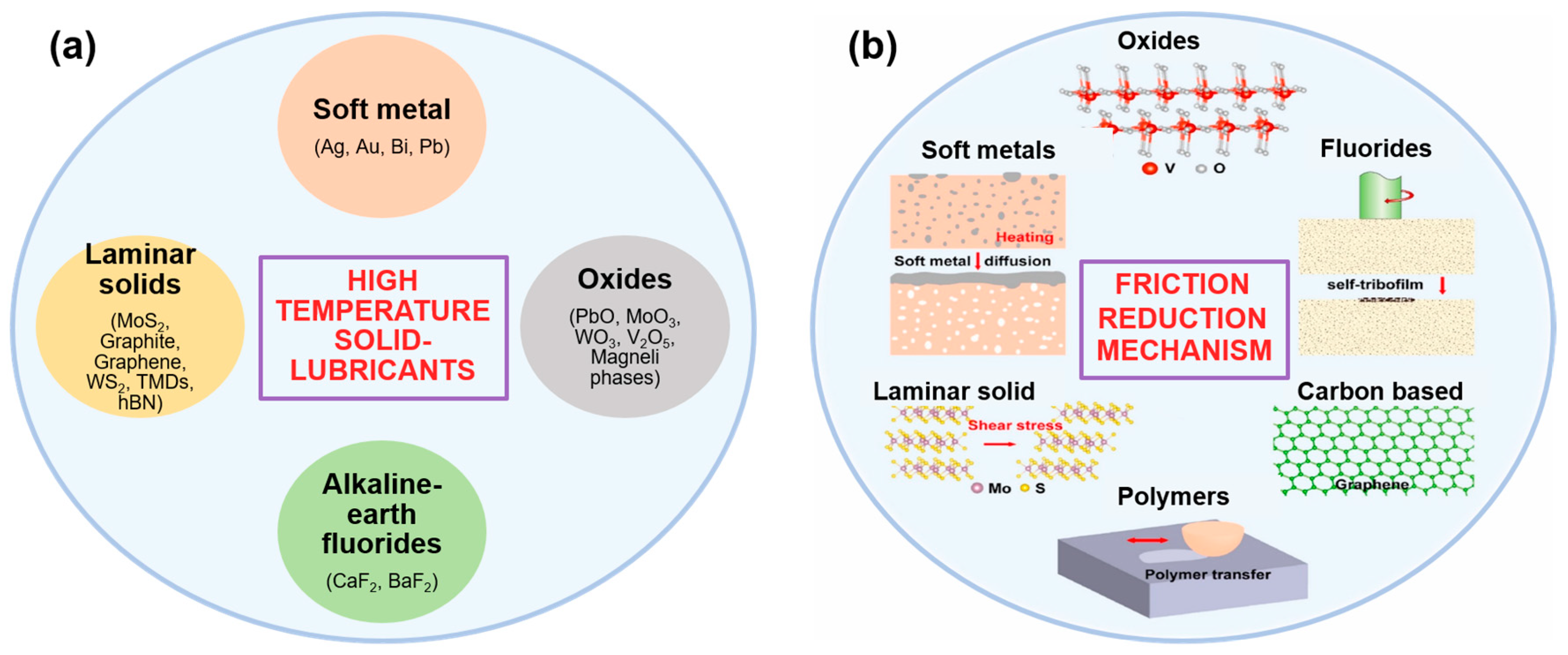
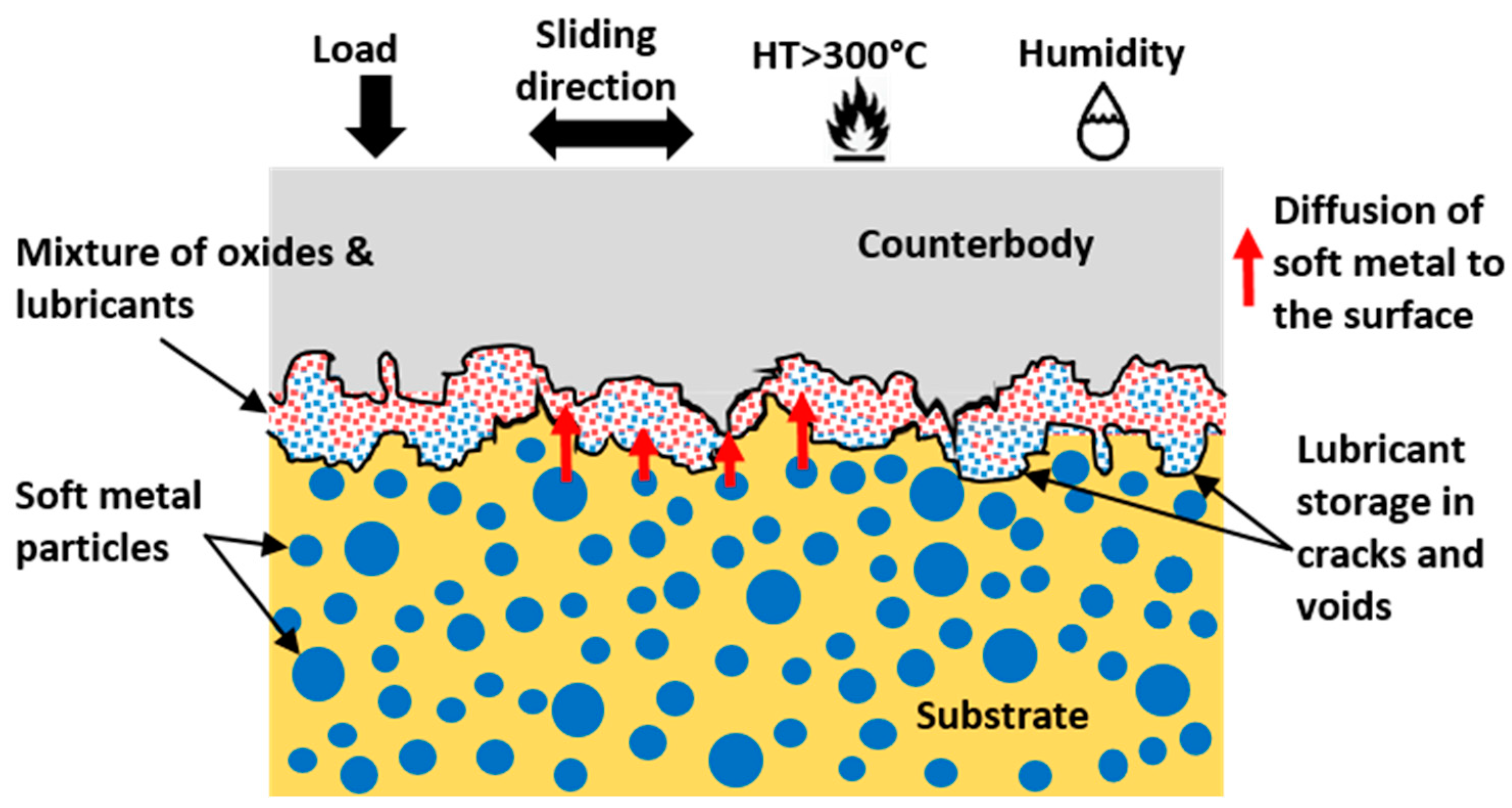
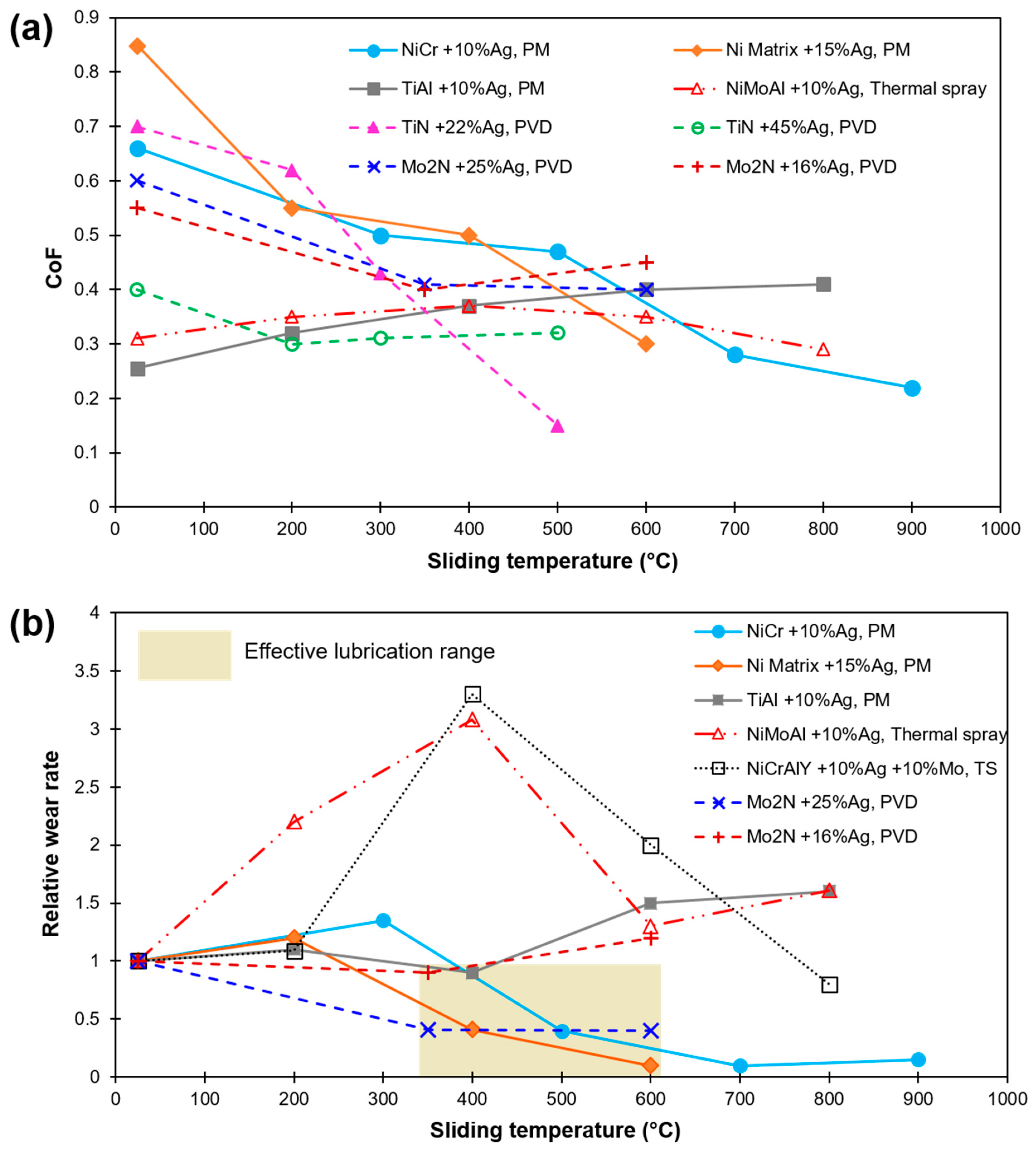
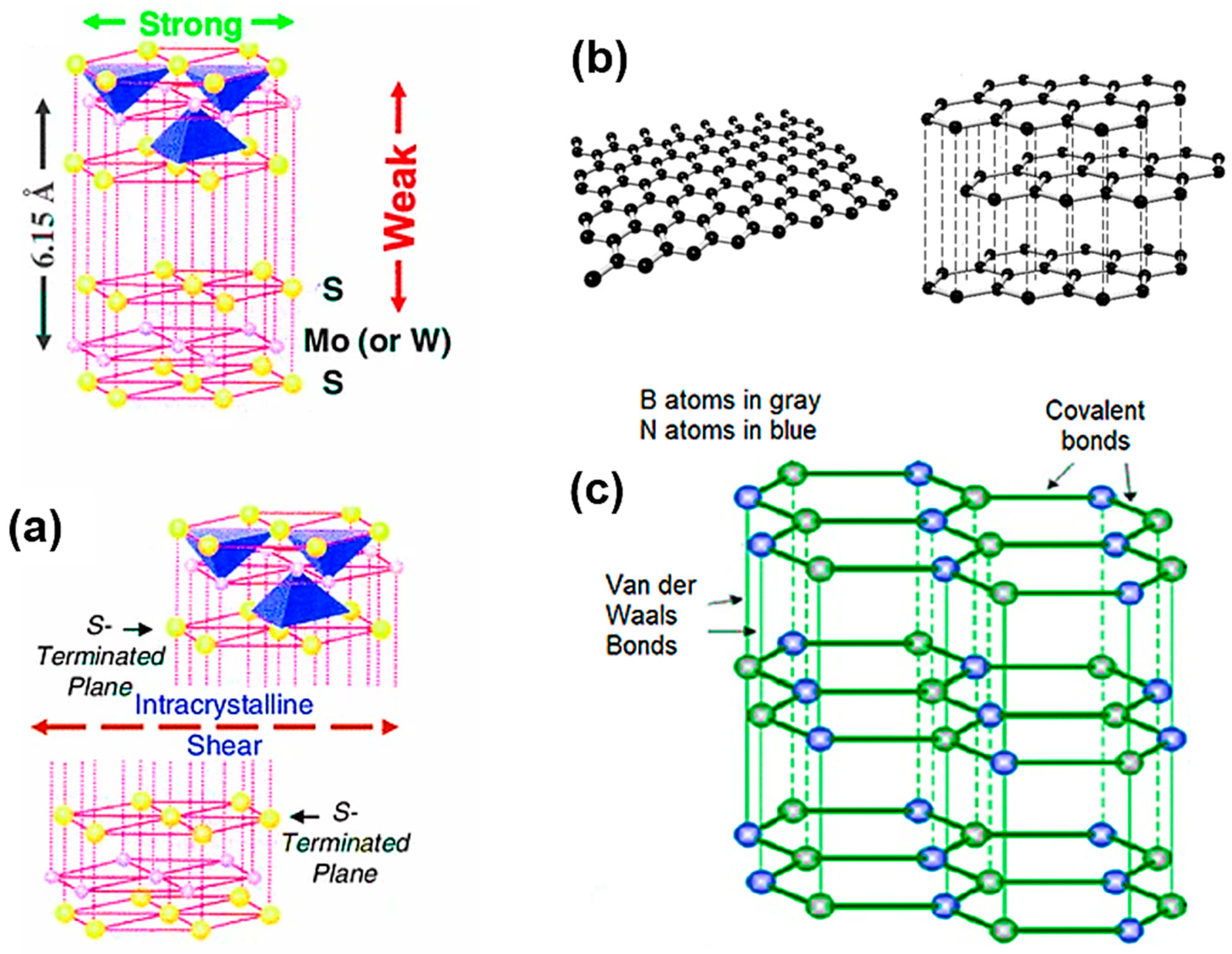
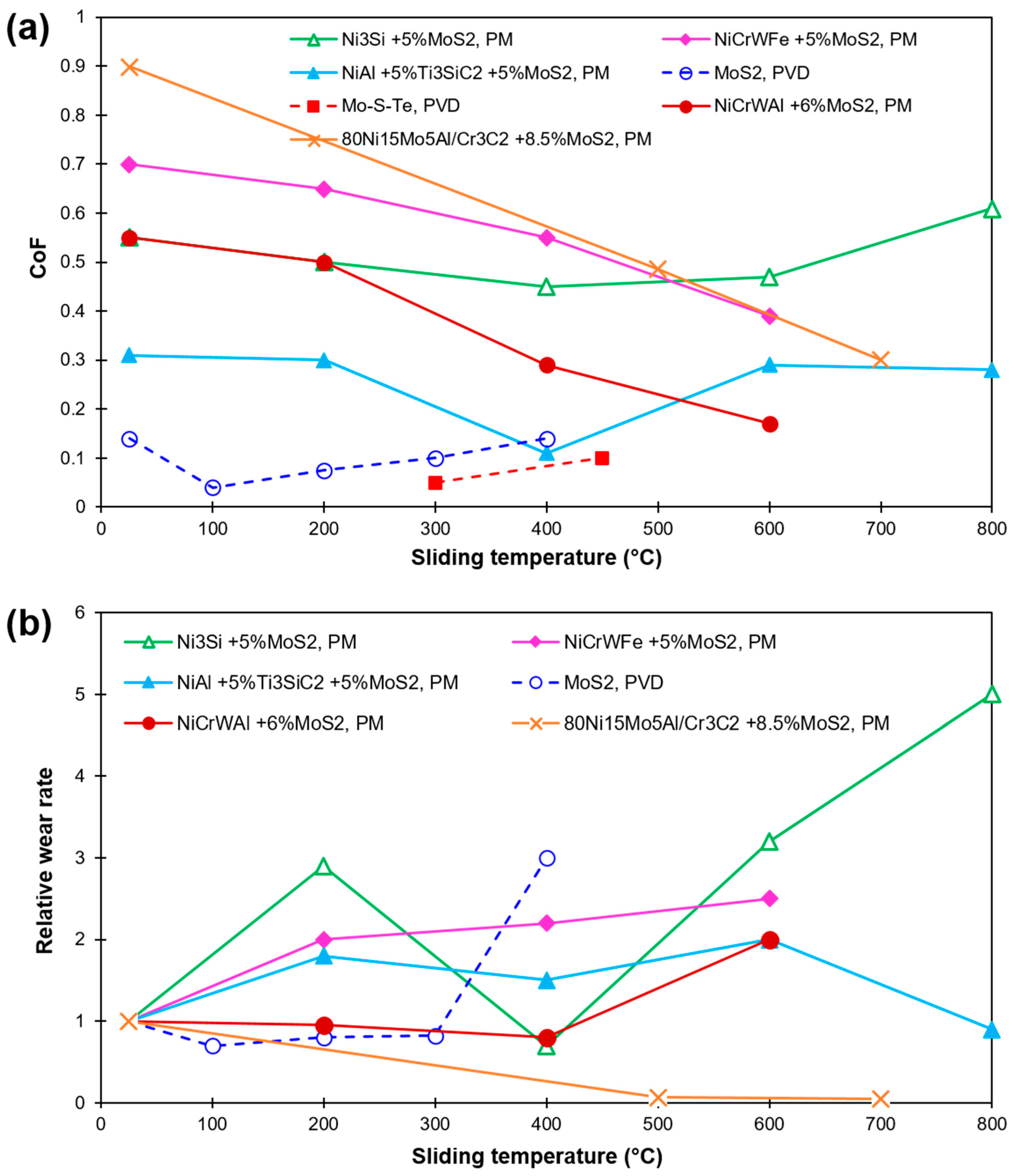
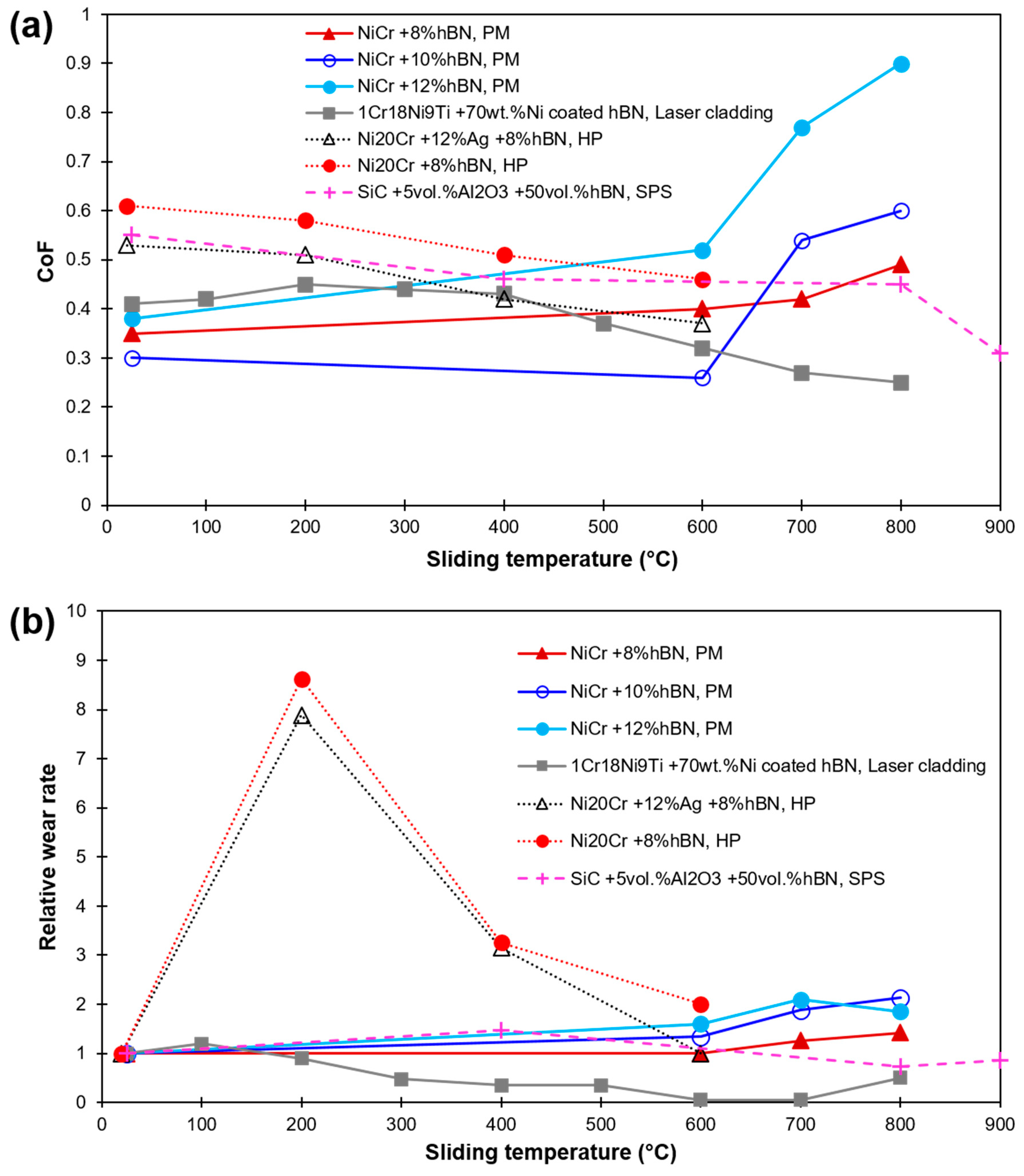
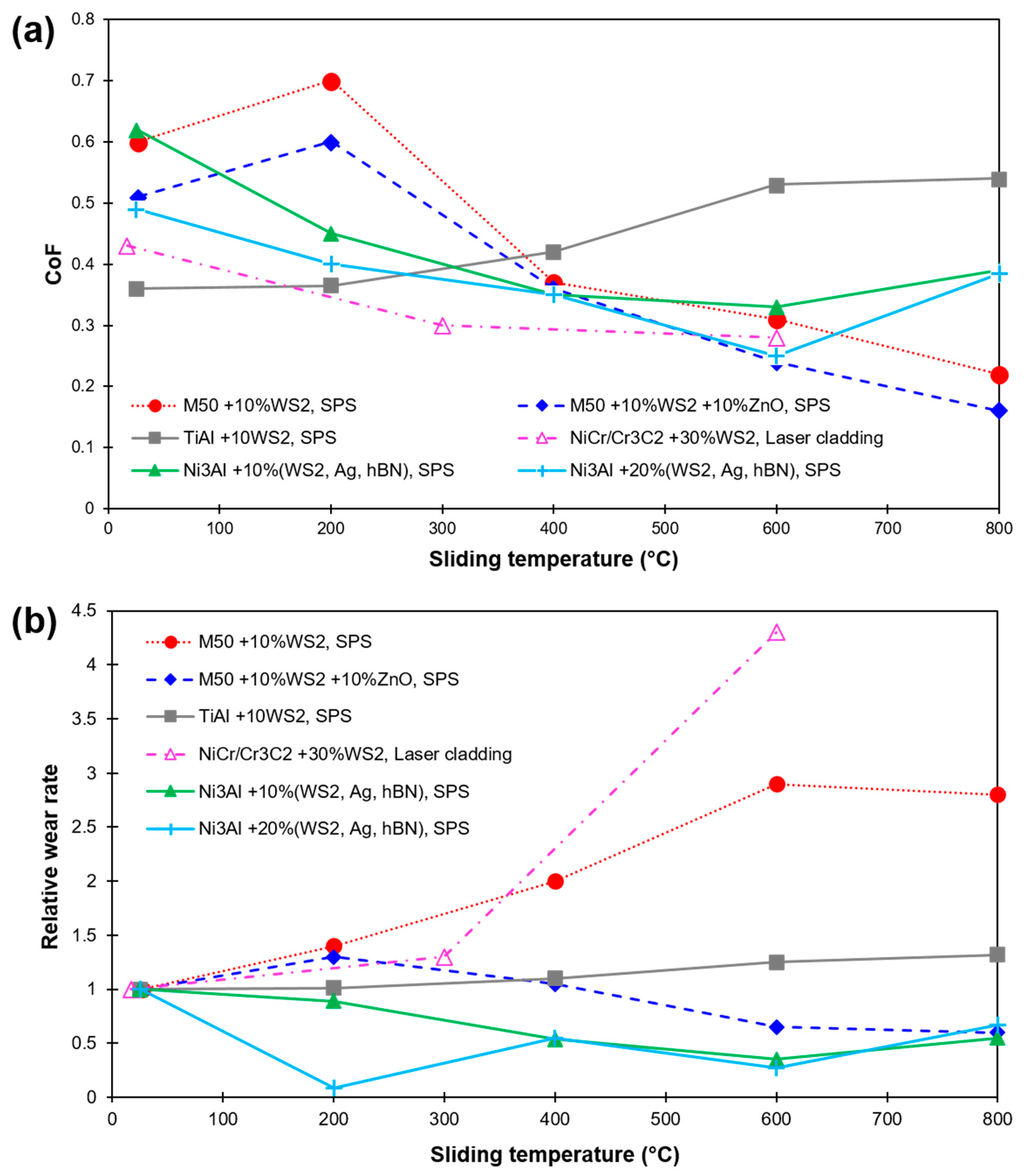
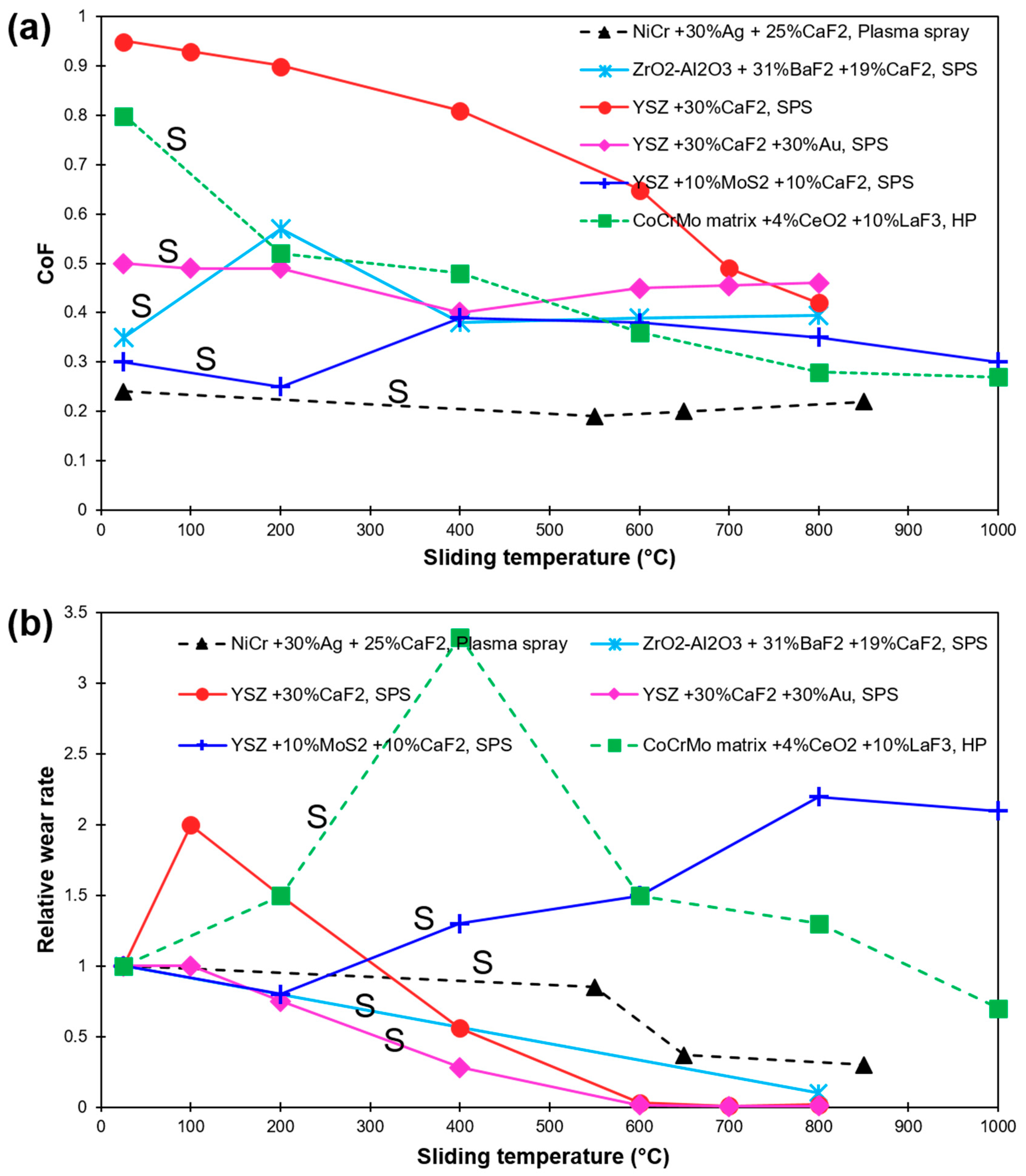
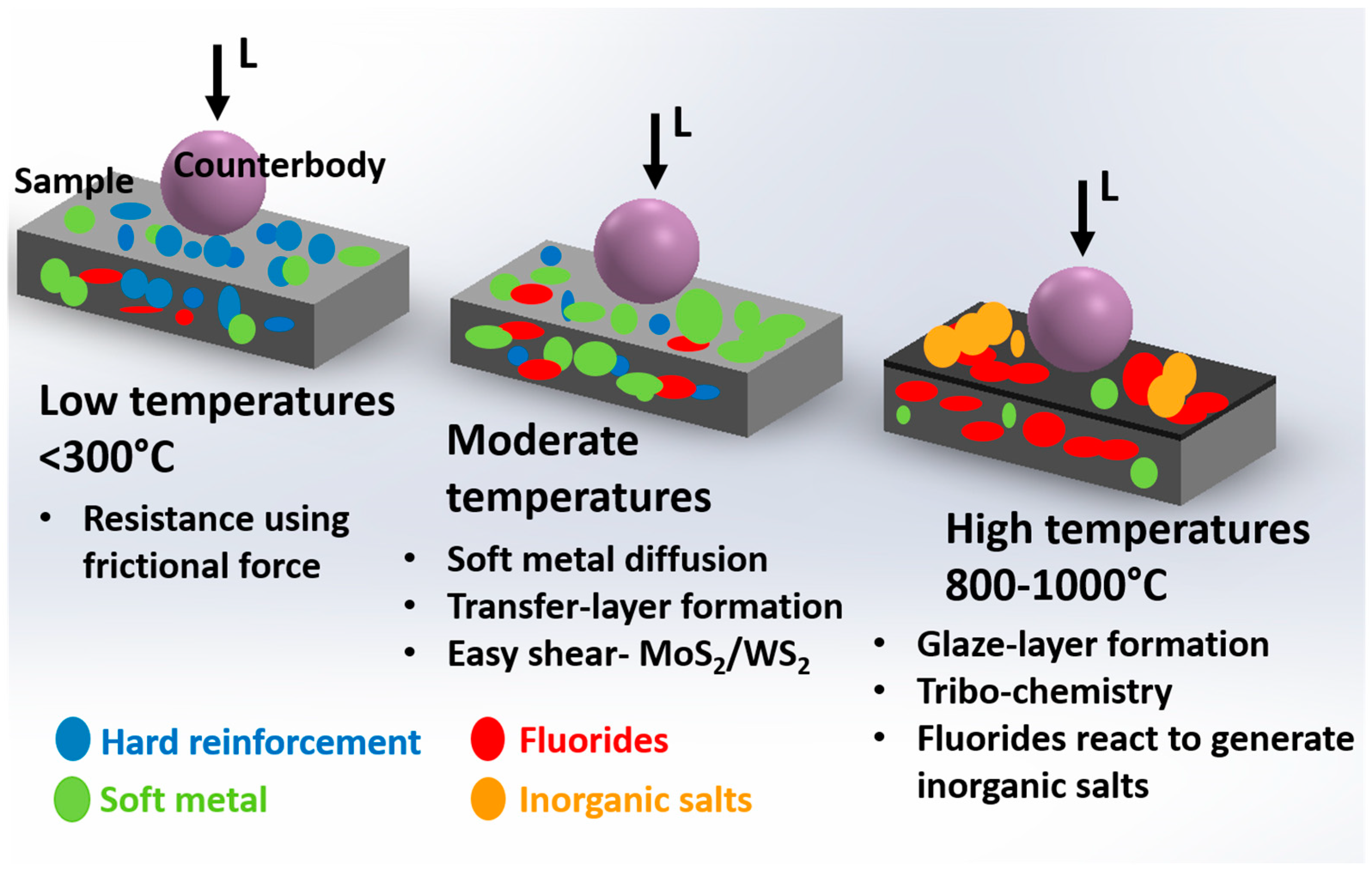

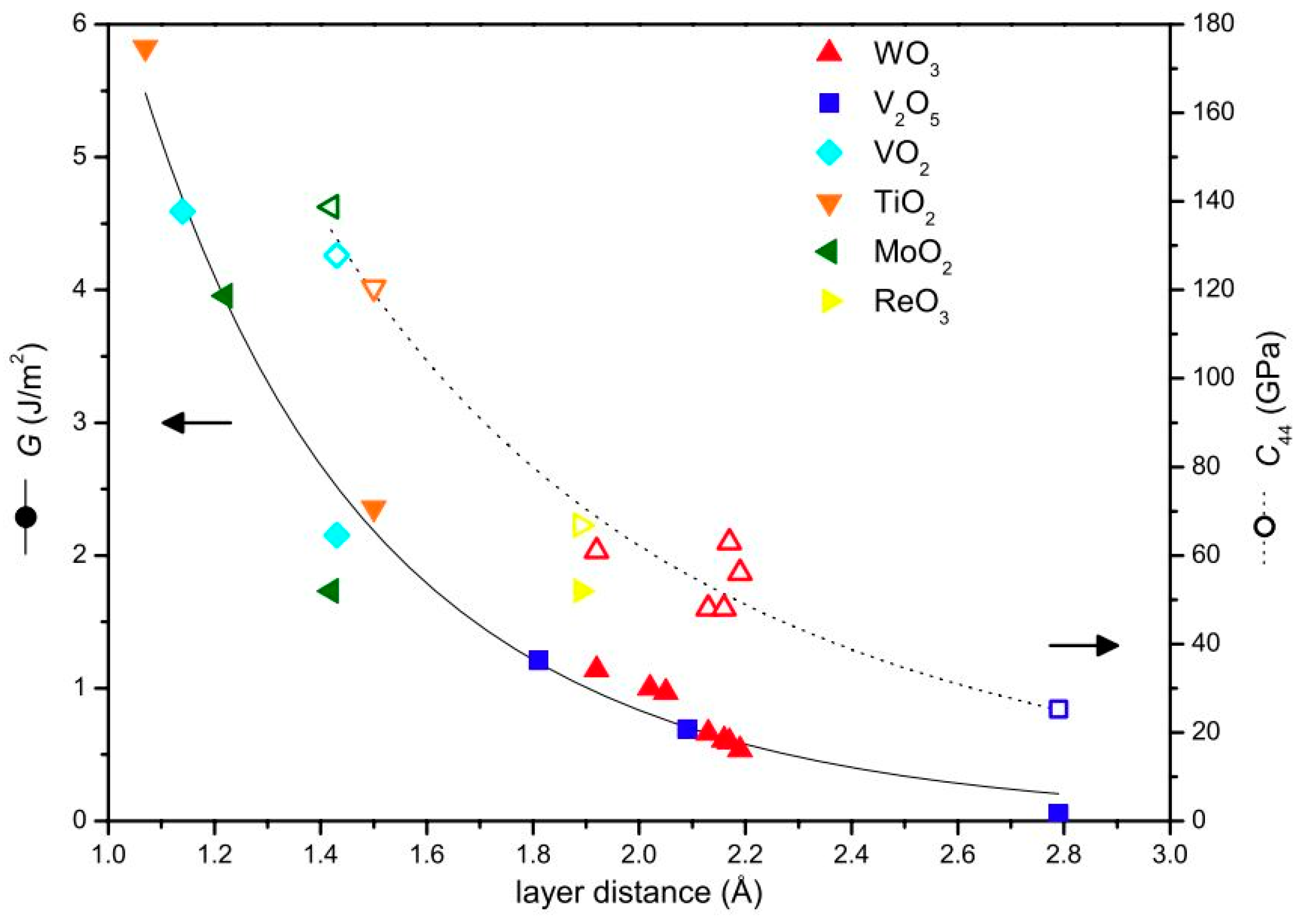

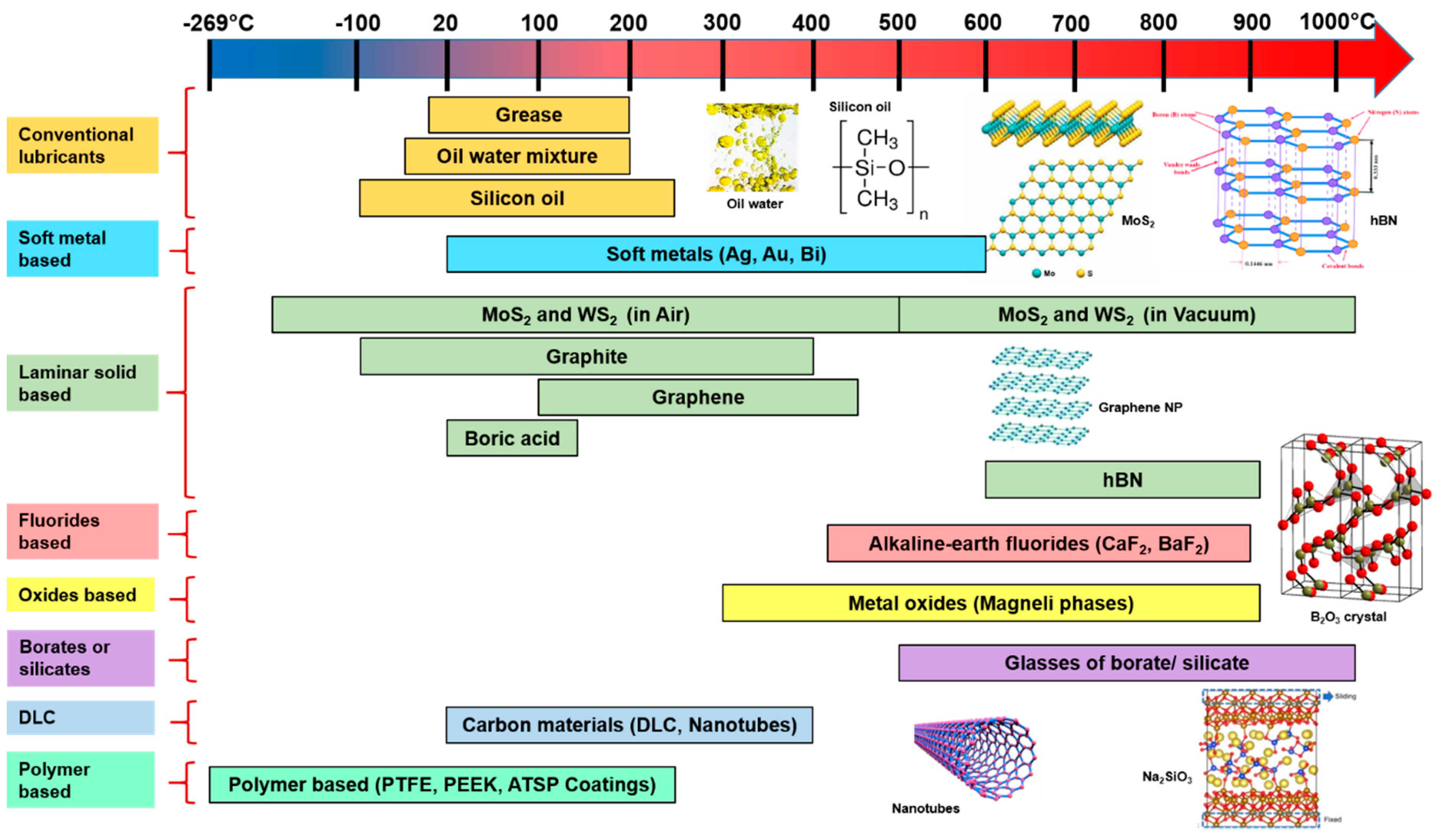
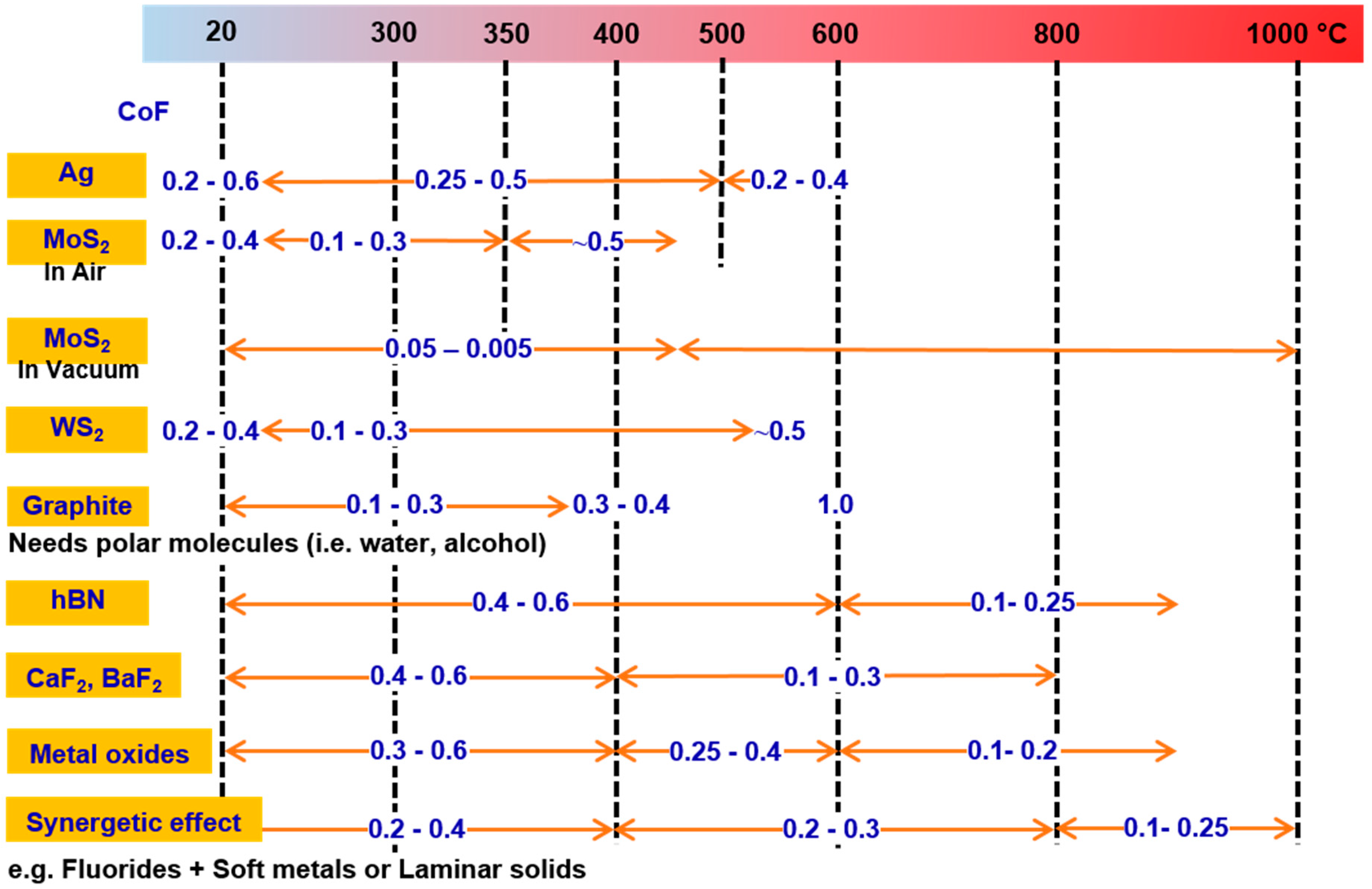
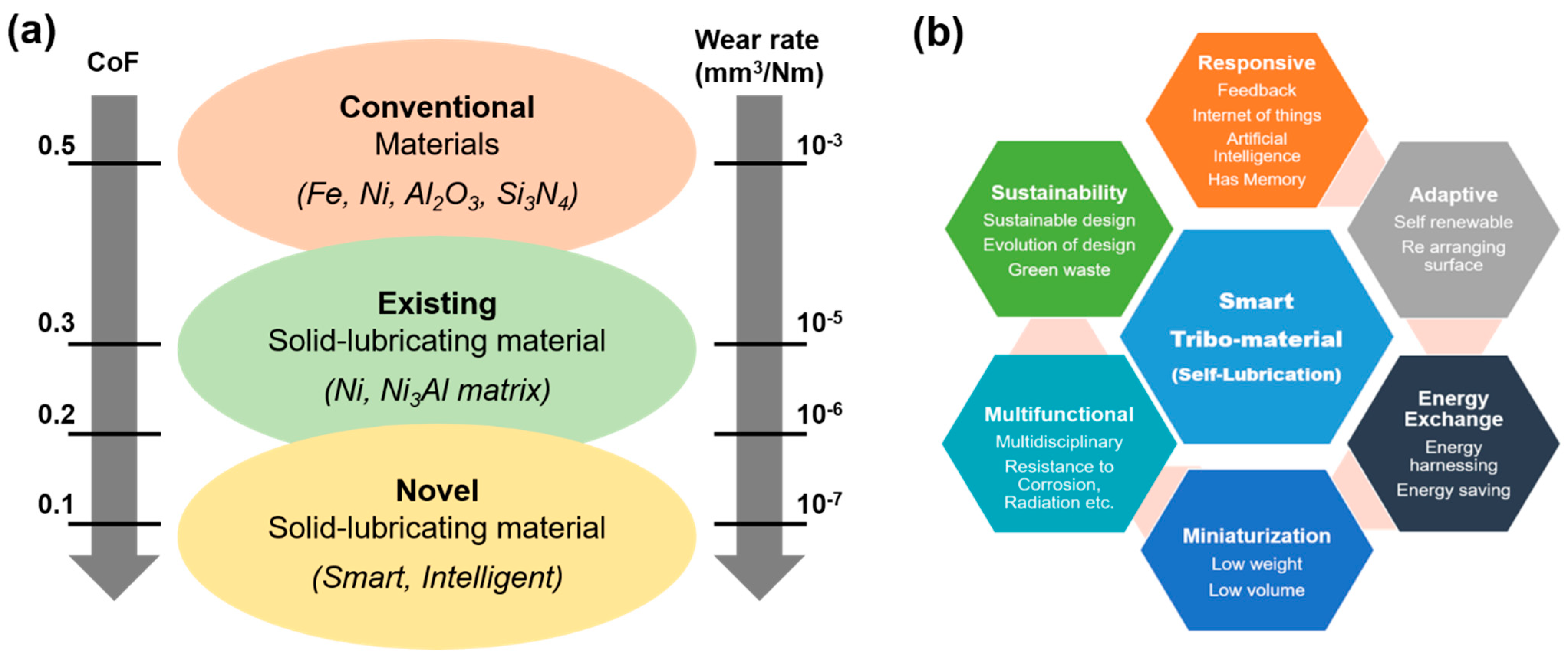
| Characteristics of High-Temperature Solid-Lubricants |
|---|
|
Publisher’s Note: MDPI stays neutral with regard to jurisdictional claims in published maps and institutional affiliations. |
© 2022 by the authors. Licensee MDPI, Basel, Switzerland. This article is an open access article distributed under the terms and conditions of the Creative Commons Attribution (CC BY) license (https://creativecommons.org/licenses/by/4.0/).
Share and Cite
Kumar, R.; Hussainova, I.; Rahmani, R.; Antonov, M. Solid Lubrication at High-Temperatures—A Review. Materials 2022, 15, 1695. https://doi.org/10.3390/ma15051695
Kumar R, Hussainova I, Rahmani R, Antonov M. Solid Lubrication at High-Temperatures—A Review. Materials. 2022; 15(5):1695. https://doi.org/10.3390/ma15051695
Chicago/Turabian StyleKumar, Rahul, Irina Hussainova, Ramin Rahmani, and Maksim Antonov. 2022. "Solid Lubrication at High-Temperatures—A Review" Materials 15, no. 5: 1695. https://doi.org/10.3390/ma15051695
APA StyleKumar, R., Hussainova, I., Rahmani, R., & Antonov, M. (2022). Solid Lubrication at High-Temperatures—A Review. Materials, 15(5), 1695. https://doi.org/10.3390/ma15051695









